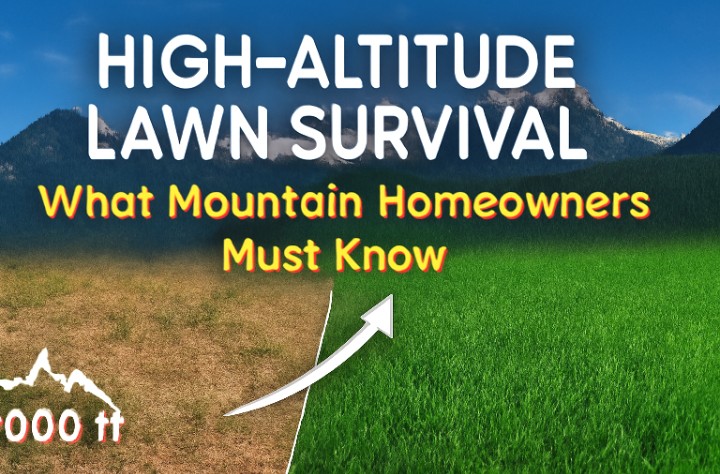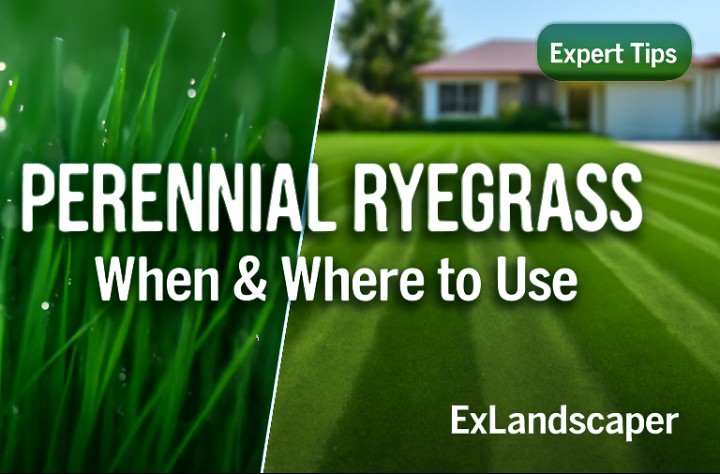WHY YOUR VALLEY NEIGHBOR’S LAWN ADVICE WON’T WORK UP HERE
You moved to the mountains. Beautiful place. Fresh air. Snow-capped peaks. But then you look at your yard, and… well, getting anything to grow is turning into a headache.
Here’s what I have learned from talking to mountain homeowners: what works at sea level does not translate. At all. Your elevation completely rewrites the rules. Temperature drops. Growing season shrinks dramatically. Soil behaves differently. The air itself is thinner.
It’s frustrating at first. But once you stop fighting it and work with what actually grows at your height, things get easier. That’s what we are figuring out together.
START WITH YOUR EXACT ELEVATION IT’S NOT JUST A NUMBER
The altitude where you live determines almost everything. Seriously. Not tomorrow, not eventually. Today.
5,000 to 7,000 Feet: Still Workable Territory
At this height, you are entering cool-climate zone. Standard turf grasses can actually make it here. Winter’s cold enough. Summer’s manageable. You get enough growing time before the hard freeze arrives. Many homeowners at this level see genuine success without losing their minds.
7,000 to 9,000 Feet: Things Get Tricky
Now it gets interesting. Your growing season compresses into just a few months. Frost shows up in September, sometimes earlier. The sun’s radiation hits harder because there’s less atmosphere protecting you. It’s intense. Most traditional lawn grasses run out of time. They can’t mature before winter shuts everything down.
Above 9,000 Feet: You are In Another World
Standard lawn grass basically does not work anymore. This is alpine territory. Most folks at these elevations give up on turf entirely. They go meadow-style natives, wildflowers, natural texture. It actually looks good once you accept it. And maintenance? Almost nothing.
LOOK AROUND YOUR PROPERTY FIRST THE OBVIOUS STUFF PEOPLE MISS
Before you buy seeds or call contractors, walk your land. Actually observe it.
Sunlight Actually Varies On Your Property
North side of your house? Way different from the south side. Are those peaks creating afternoon shadows? Does the sun hit everywhere equally? It doesn’t. Full sun spots need different grasses than shaded areas. Mountain properties have extreme microclimates. Seriously. Your neighbor’s yard fifty feet away gets completely different conditions.
Your Soil Is Probably Not What You Think
Dig around. Sandy loam? Common at altitude. Drains fast sometimes too fast. Clay soil holds water but compacts easily. Rocky soil shows up everywhere up here. Test your pH. Mountain soils lean acidic. Drainage matters hugely because standing water kills roots. One puddle that won’t drain becomes a dead zone permanently.
Where Does Water Actually Come From On Your Property?
Are you counting on rainfall? Snowmelt? Can you realistically install irrigation? Some regions get monsoons in late summer. Others get nothing predictable. Know what you are working with before making plans.
Wind and Slope Change Everything
Ridgetops are brutal constant wind dries everything. Exposed slopes shed water immediately. Protected valleys? They are forgiving. Steep areas create erosion problems. Flat spots don’t exist much up here. But where they do, grass loves them.
All these factors work together. Miss one, and you’re frustrated for two years.
MATCH YOUR HEIGHT TO GRASSES THAT ACTUALLY WANT TO BE THERE
5,000 to 7,500 Feet: You Have Real Options
You are lucky at this elevation. Multiple grasses thrive here.
Kentucky Bluegrass is the workhorse. Grows in garbage soil. Gets torn up and comes back. Spreads underground heals itself. Bare patches? It fills them in on its own. People use this for a reason.
Perennial Ryegrass germinates fast. Acts as a protective cover while slower species establish. You get something green while roots are getting deep. Smart approach.
Fine Fescues (Creeping Red, Hard, Chewings varieties) handle shade. Need less mowing. Actually prefer drier conditions. They grow in rocky, terrible soil when other grasses quit. The blades are fine and attractive.
Real talk: mix all three together. You get better color, durability, and recovery. Seed companies now breed specifically for mountain conditions. Find those varieties.
7,500 to 9,500 Feet: Native Species Make Sense Now
At these elevations, switching to native grasses is not compromise it’s smart thinking. These plants survived thousands of years in your exact climate. They know what they’re doing.
Blue Grama surprises people. It’s a native warm-season grass tougher to cold than expected. Grows 1 to 1.5 feet tall. Fine texture. Pest-resistant. Tolerates poor soil. Put it on south and west slopes it thrives with maximum sun.
Sheep Fescue is genuinely tough. Bunchgrass that adapts to almost any soil. Erosion control is its specialty. Once established, maintenance practically disappears.
Idaho Fescue grows as dense clumps. Belongs at elevation. Protects slopes from washing away.
Western Wheatgrass has bluish stems, grows 1 to 3 feet tall. Here’s the weird part: it handles both flooding and drought. That versatility matters when mountain weather does unpredictable things.
Smart landscapers combine these species. Layered coverage. Better appearance. Real resilience.
9,000+ Feet: Forget Traditional Lawn, Go Meadow
Be honest with yourself. True turf does not work up here. Shift your thinking.
Native blends at these heights include species naturally found at similar elevations in your region. Some homeowners embrace it grasses, wildflowers, prairie appearance. No mowing. No fussing. Actually beautiful once you accept it.
These mixes thrive on neglect. Conditions destroying standard turf? They don’t faze these plants.
SEED QUALITY MATTERS MORE THAN PEOPLE THINK
Don’t grab the cheapest bag. Regional origin changes everything.
Seed bred for your specific elevation adapts better than lowland seed. It’s already been tested in your climate. Buy certified seed when possible tested for purity and germination. Look for mixes specifically formulated for your elevation zone.
Pawnee Buttes in Greeley, Colorado understands mountain climates. Regional native plant nurseries do too. They are local experts. Use them.
TIMING: LATE SUMMER INTO FALL IS YOUR ONLY REAL WINDOW
Mark your calendar: late August through September. That’s it.
Cool-season grasses wake up when temperatures drop. Soil’s still warm from summer perfect for germination. Weeds like crabgrass already finished their cycle. You are not competing.
October works but it’s risky. Push too late and seedlings don’t establish before winter hits hard. Call your county extension agent they know your exact first-frost date.
Soil temperature needs 50 to 65 degrees Fahrenheit for cool-season seed. Spring planting? Sounds logical but it’s worse. Young plants don’t have deep roots when summer stress arrives. They struggle and often fail.
Native grasses work differently. Late fall, right before first snow, is ideal for dryland sites at higher elevations. Seed germinates when spring soil warms, after winter’s natural dormancy-breaking.
PREPARE YOUR SOIL PROPERLY OR WASTE YOUR TIME AND MONEY
This separates people who succeed from people who waste money.
Remove weeds, rocks, and debris first. Loosen the top two inches. Compacted soil suffocates new roots. Add fresh topsoil to bare spots.
Level everything. Big dips collect water and create disease problems. Use a water roller for a firm seedbed, but don’t overdo machinery.
For problem areas, consider drilling seed instead of broadcasting. Drilled seed goes directly into soil and germinates better. Broadcasting works but you need double the seed to account for wind and birds.
Seed rates typically run 3 to 5 pounds per 1,000 square feet. Check your specific variety.
WATERING DURING GERMINATION: THE PART EVERYONE UNDERESTIMATES
New seed needs staying moisture. Top soil should stay damp for 2 to 3 weeks until seedlings emerge.
At altitude, moisture evaporates rapidly. Rain alone might not be enough, especially in dry years. Daily light watering beats occasional deep soaking.
Once seedlings hit 3 inches, start backing off frequency. Established native grasses drink way less than traditional turf. That’s honestly one of their biggest advantages.
YEAR TWO: WHEN EVERYTHING FINALLY CLICKS
Don’t expect perfection in year one. Not realistic.
By summer of year two, most homeowners see real improvement. Complete establishment takes the full two years. Grasses keep deepening roots through fall and into winter. Next spring they’re stronger and tougher than spring-planted grass could ever be.
It’s worth waiting. Year-two grass handles conditions that would wreck younger plants.
MISTAKES PEOPLE ACTUALLY MAKE (AND HOW TO AVOID THEM)
Using Low-Elevation Species. Just because something grows in Denver does not mean 8,500 feet works. Elevation changes everything. Don’t assume.
Skipping Soil Prep. Planting into unworked, compacted earth wastes everything. Spend the time preparing.
Seeding In Spring. Sounds logical. It’s actually harder. Late summer is proven better.
Ignoring Native Blends Above 7,500 Feet. You are fighting biology. Native species exist for a reason.
Sporadic Watering During Germination. Seeds dry out and fail. Consistency matters more than anything those first weeks.
REALISTIC TIMELINE: PATIENCE BEATS EVERYTHING
Full establishment takes 1 to 2 years in mountain zones. Slower than valley lawns? Yes. That’s mountain living.
Year one brings germination and early growth. Your lawn looks sparse or patchy. Normal. Underground, roots build deep networks.
Year two fills things in. Disease resistance improves. Maintenance drops. That’s when you realize patience paid off.
THE END: STOP FIGHTING YOUR ELEVATION
Mountain lawns operate by different rules. Valley techniques don’t work.
Match your grass to your actual elevation and conditions. Don’t replicate what grows downtown. Your snowy peaks, thin air, and compressed growing season create opportunities for grasses that can’t survive lower down.
Two years from now, after patience and smart species selection, you will have a lawn that belongs on a mountainside. Hardy. Resilient. Actually beautiful. Built to last decades.
That’s worth the wait.






